India, a land of vibrant cultures and rapid development, faces a daunting challenge that threatens its very lifeblood: water contamination. Its cities, engines of economic growth and home to millions, are grappling with a crisis of polluted water sources, posing a grave threat to public health, environmental sustainability, and the overall quality of life.
The Grim Reality: Sources of Contamination
The roots of India’s urban water contamination lie in a complex web of factors:
- Untreated Sewage: Perhaps the most significant contributor, a vast amount of domestic sewage generated in India’s cities flows directly into rivers, lakes, and groundwater sources without adequate treatment. This introduces harmful pathogens, organic matter, and chemicals into the water supply.
- Industrial Effluents: Rapid industrialization without stringent environmental regulations has resulted in the discharge of toxic heavy metals, chemicals, and other hazardous pollutants into water bodies. Industries like textile dyeing, tanning, and chemical manufacturing are major culprits.
- Agricultural Runoff: The excessive use of fertilizers and pesticides in agriculture, carried away by rainwater or irrigation flows, contaminates both surface water and groundwater sources. This introduces nitrates, phosphates, and other harmful chemicals into the water system.
- Religious Rituals: While deeply ingrained in cultural practices, the immersion of idols, ritualistic offerings, and disposal of human remains in rivers like the Ganges contribute to bacterial contamination and the accumulation of solid waste.
- Poor Waste Management: Inadequate solid waste collection and disposal lead to toxins and leachates from landfills seeping into waterways and groundwater, further compounding the contamination problem.
The Dire Consequences
The effects of water contamination in Indian cities are widespread and alarming:
- Public Health Crisis: Consumption of contaminated water leads to a host of waterborne diseases such as cholera, typhoid, dysentery, and diarrhea. These diseases disproportionately affect the poor and vulnerable, especially children, leading to significant morbidity and mortality.
- Environmental Degradation: Water pollution severely damages aquatic ecosystems, killing fish and other organisms, disrupting the delicate balance of riverine and lake environments. This degradation has cascading effects on biodiversity, water quality, and livelihoods reliant on these ecosystems.
- Water Scarcity: Contamination renders vast quantities of water unusable for drinking, domestic purposes, or agriculture. This exacerbates existing water scarcity issues, particularly in rapidly growing cities facing increasing water demand.
- Economic Burden: The costs associated with water contamination are staggering. Healthcare expenses for treating waterborne diseases, loss of productivity due to illness, and the need for expensive water treatment technologies place a significant strain on the economy and public coffers.
Statistics that Speak Volumes
The severity of India’s urban water crisis is reflected in these alarming figures:
- Grim Assessment: The Composite Water Management Index (CWMI) report by NITI Aayog in 2018 revealed that 70% of India’s available water is contaminated.
- Major Cities in Crisis: Cities like Delhi, Mumbai, Kolkata, and Chennai struggle with heavily polluted rivers and severely contaminated groundwater.
- Staggering Illness: The World Bank estimates that 21% of communicable diseases in India are linked to unsafe water, leading to over 500 child deaths from diarrhea every day.
The Path Forward: A Multi-pronged Approach
Addressing India’s urban water contamination crisis demands immediate and comprehensive action:
- Enforce Strict Regulations: Stringent enforcement of environmental regulations is needed to curb industrial pollution and mandate wastewater treatment by factories. Penalties for non-compliance must be severe to act as a deterrent.
- Invest in Infrastructure: Massive investments are required in building modern sewage treatment plants, improving urban sanitation networks, and upgrading water distribution systems to prevent leakages and contamination during transit.
- Sustainable Agriculture: Promoting organic farming practices, reduced fertilizer and pesticide use, and efficient irrigation techniques are essential to minimize agricultural runoff and its contamination of water sources.
- Waste Management Revamp: Implementing effective solid waste segregation, recycling, and scientific landfill management is crucial to prevent pollution from landfill leachates.
- Public Awareness: Campaigns to educate citizens about the dangers of water pollution, responsible waste disposal, and water conservation are vital to bring behavioral change.
A Call to Action
India’s water contamination problem is not insurmountable, but it demands a concerted and sustained effort from the government, private sector, and the public. By addressing the root causes, investing heavily in treatment infrastructure, and promoting sustainable practices, India can reclaim its precious water resources for a healthier, more prosperous, and ecologically sustainable future. The time for action is now.






